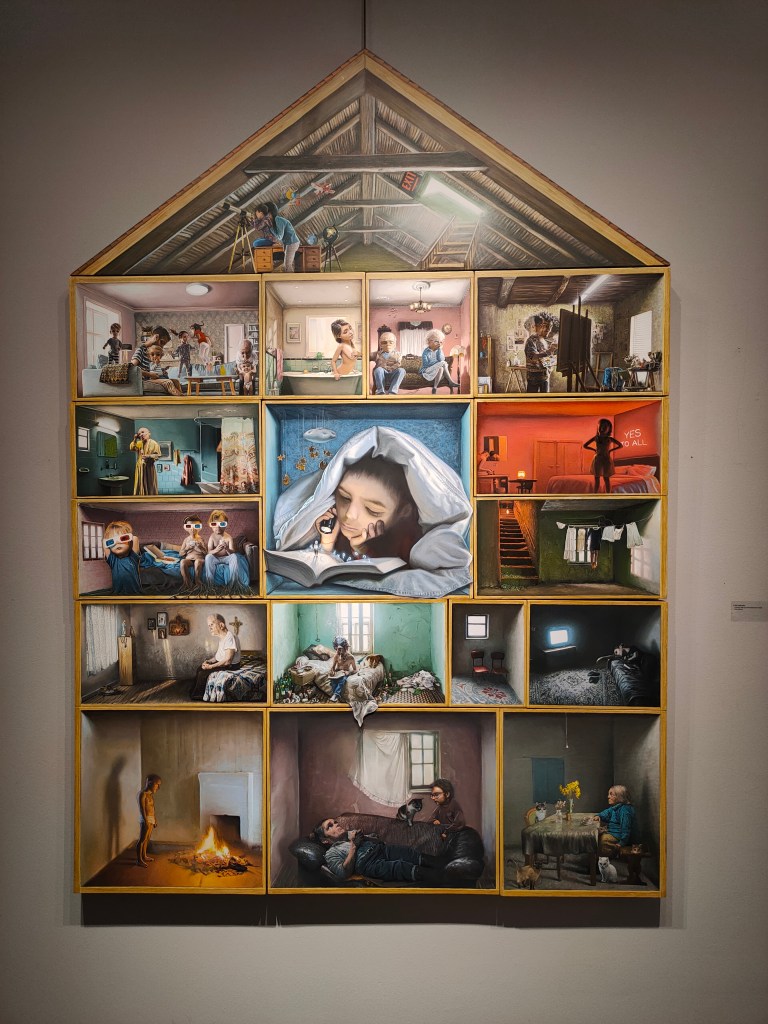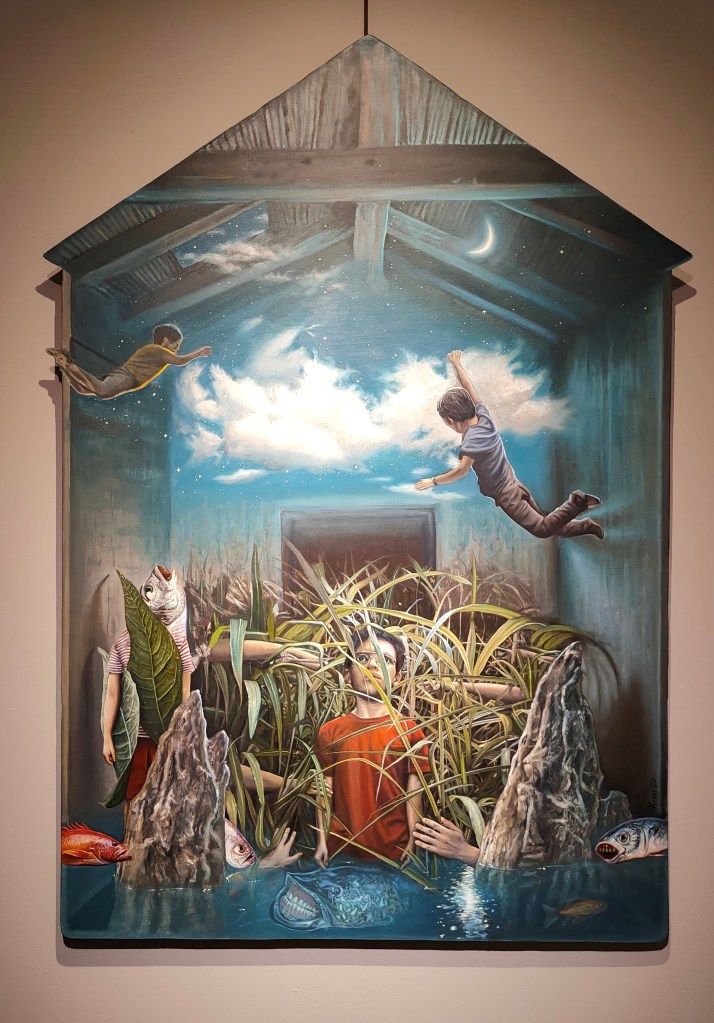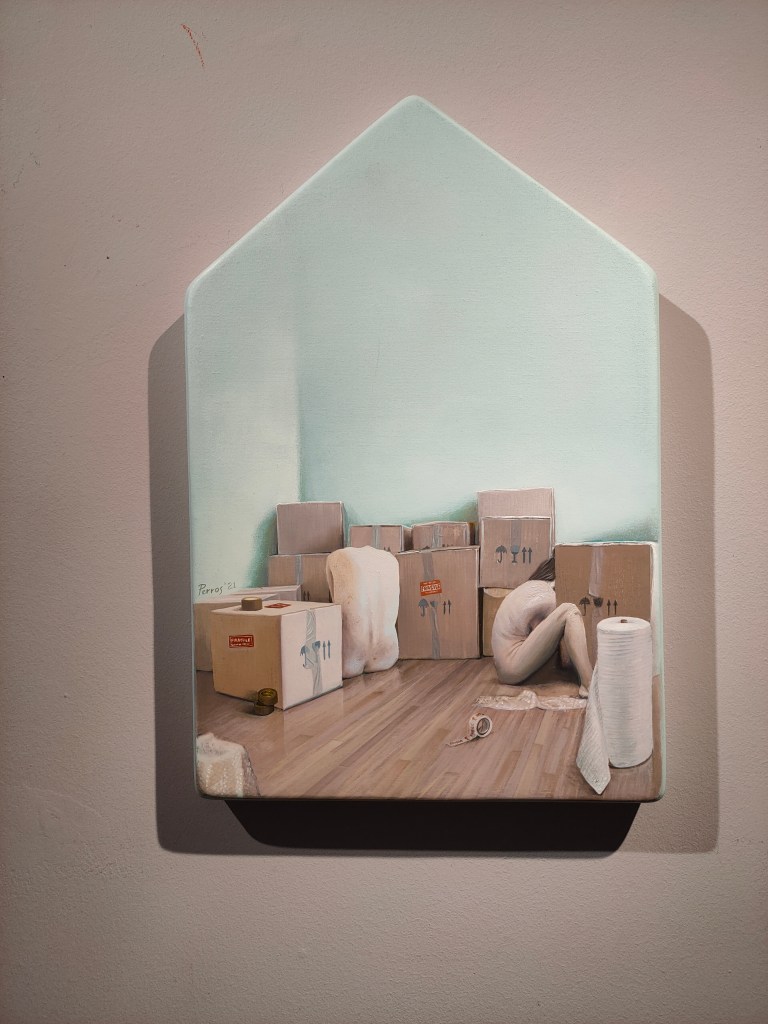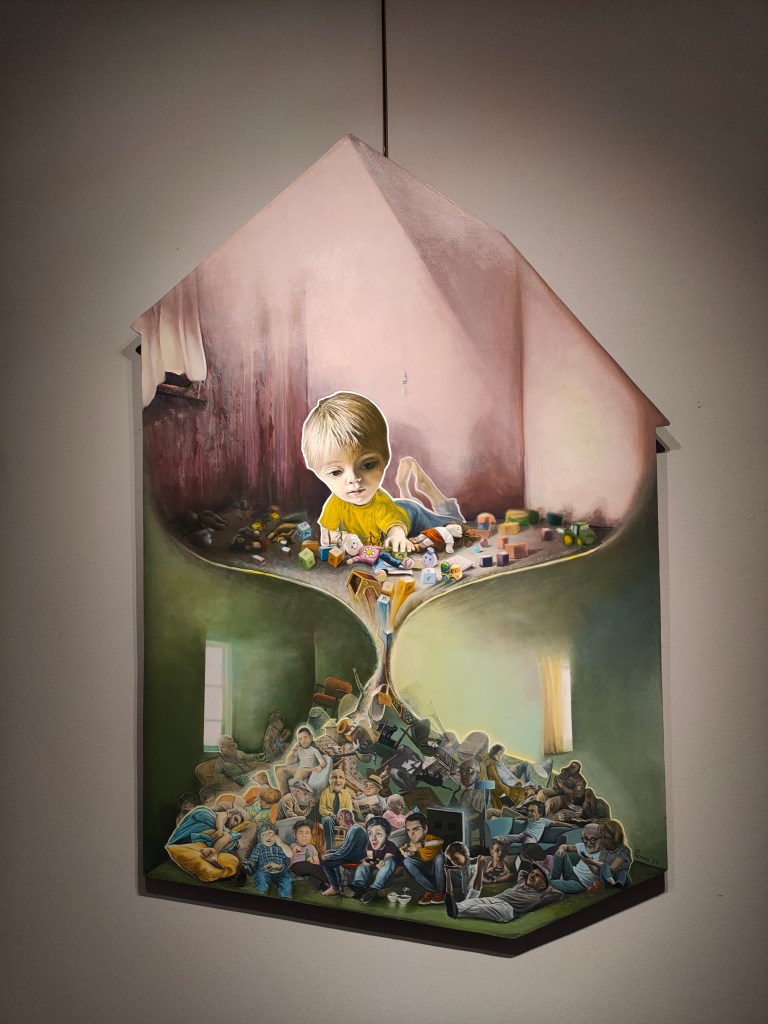ARTIST Vassilis Perros talks to Stella Sevastopoulos about the multi-faceted concept of the home and how he has explored it in his new series of works on show at Skoufa Gallery:
Vassilis Perros presents us with his new series of works, created from 2019 onwards, in a profound show entitled ‘Domo’, curated by George Mylonas, and running till March 12 at Kolonaki’s Skoufa Gallery. The kaleidoscopic nature of the home and its changeability, which we have witnessed especially during the lockdown, are colourfully and imaginatively explored by the artist: From refuge to prison, the space of our dreams and/or our nightmares. Perros’s works analyse the concept of the home in an ultra-contemporary manner, via a unique art form in which intricately detailed, realistic oil painting renditions of human forms are transformed through the influence of images taken from modern animation, technology or even avatars. The irregularly shaped canvases upon which many of Perros’s scenes of domestic life are played out on, add another interesting angle to his art. They cross the lines between wall sculpture and the shaped canvas, also borrowing from the tradition of ‘decoupage’, in order to create an entirely new and unique art form.

“I had started working on the theme of the home before the pandemic. Then with the lockdown, the whole concept took on new meanings” explains the artist, whose works focus on the form of the house, within which all sorts of scenarios are being depicted, and often break through the borders of its walls and roof.
The stylized depiction of a house, is one of the first ‘symbols’ that a child will draw. Children also seem to be at the epicenter of this exhibition. They are associated with positivity, hope, energy, inspiration, escapism, the future and imagination in many of the works. The work entitled ‘Ark’, was actually inspired entirely from the words of children: Perros had asked of his 10-12 year old students to complete the phrase “Home is…” with their own words, and the answers he got simply blew him away: “Home is where I can take my mask off”, “where I am myself”, “where I want to return”, “where I keep my secrets”. Their answers allowed Perros to instantly visualize the work: “a house that would float on a sea of their phrases”.

Today, with the atrocities of war going on in the Ukraine, and the many children that have been robbed of their homes, one can say that the concept of home takes on even more importance: “When I had spread out these phrases in order to photograph them, my eye caught sight of one in particular: ‘Home is where I feel safe and where I can dream’. My mind sadistically went to the image which was like a punch in the stomach, of the Ukrainian child crying and sobbing because it had been ousted from its home in such an aggressive manner. Who dares to strip this child of its safety and with what right do they destroy the place where its dreams are born?”, asks Perros.

As a child, Perros enjoyed fantasizing of being able to fly invisibly and to visit people without them knowing. This childhood fantasy seems to also be at the basis of this series of works, because, like an invisible voyeur, Perros has explored and presented many different domestic interiors and ways of living: From the artist, or writer, who within the confines of his room, is able to escape via his creativity, to the cat lady surrounded by her furry friends, or the old man surrounded by icons. From the young woman ready for everything, to the tired mother carrying the weight of her household on her shoulders. Perros explains how “The home is a place in which we live and exist. It is the barrier between the outside world and our privacy. It isn’t defined just by the four walls and a roof, but mainly from what’s inside of it, the living space, its atmosphere, the people and moments that we experience there. Contemporary architectural structures which want open spaces in the home and big windows and balconies, are basically an extension of the human need for more contact with the environment and less isolation.”

The artistic process for creating these works is a unique mix of materials and methods. The artist explains how it was the concept of the home that led the way: “The shaped canvases which are used in most of the works, aren’t something that the public is familiar with. And so, people keep on asking me about them. But I was driven to create these shaped canvases from my need to isolate the main subject from its background. Seeing as I focus on the content of the homes, and I’m not interested in what’s going on outside of them, their context or background, is totally superfluous. I wanted the interiors to appear self-existent, totally cut off from their environment and not to be redefined by anywhere/anything else. Consequently, the solution of the shaped canvas was the only route. This whole process of the irregularly-shaped canvas, cutting out its outline, then copying exactly that outline onto a piece of plywood, then cutting the plywood and sticking the canvas onto the plywood so that it adheres perfectly and smoothly, is a tricky one.”

Another influence in Perros’s work is the internet and the wealth of images that can be found there. Perros explains how the internet has changed the art world in many ways: “The internet has changed our whole lives but it has also caused mayhem in the art world (eg. with cryptoart and NFT). For me, the internet is a giant tank where material is collected and available for processing. From there I collect photographs which interest me, I heavily process them so that they become unrecognizable and I use elements from them in my art (e.g. A very aged face, an animal, body movements which cannot be posed for etc). Furthermore, through the internet, I gain information on the latest art trends around the world. It enables visits to museums, access to articles on art etc. One should also mention the role of the internet in terms of allowing one’s art to communicate with an audience but also for artists to be able to communicate with one another: social media in particular aids this.”

The element of escapism is also prevalent in this exhibition. In the exhibition catalogue there’s a dedication: “Dedicated to those of us who, when suffocated by reality, turn to the sky”. This message of hope seems to run through the exhibition. “I wanted my exhibition to leave a small opening towards the sky, a touch of positivity. We are living in very difficult times and woe betide us if art is introspective and depressing. My artworks on the one hand might document a dystopian and gloomy reality but there’s also a little chink of light in there – a wink of an eye. It’s up to us if we follow that light. Art just shows us the exit.”
- On March 5, 12.30pm, art historian and curator of the exhibition George Mylonas will be talking about Perros’s work (in Greek), followed by a discussion with Vassilis Perros.
- Skoufa Gallery is on 4 Skoufa Street, Kolonaki. Open Monday, Wednesday 10am-4pm; Tuesday, Thursday 10am-9pm; Friday 10am-8pm; Saturday 10.30am-3.30pm.
- ‘Art Scene Athens’ is written and run by artist/journalist Stella Sevastopoulos, who has been covering the Greek art scene since she moved from London to Athens in 1994. For examples of her artwork, you may visit her online portfolio.

Such poignant images, especially the third from the top, thank you!
LikeLiked by 1 person
An amazing artist who has a very contemporary perspective. Highly skilled!
LikeLiked by 2 people